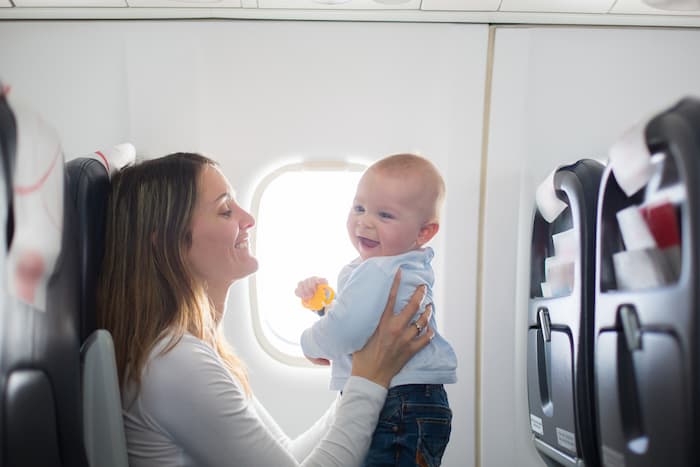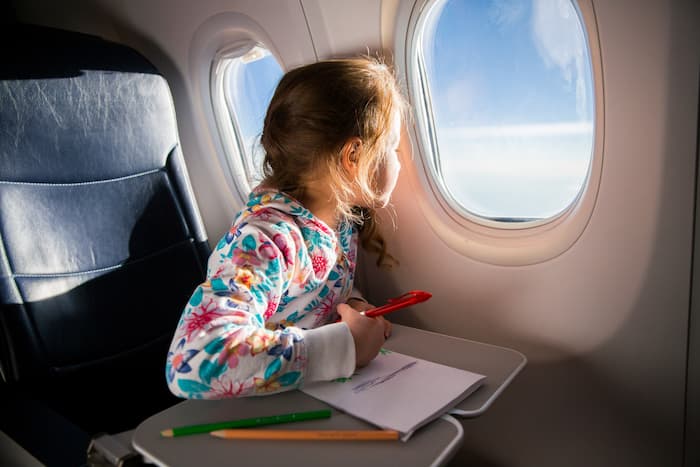Flying with a baby or toddler can be challenging. Whether you're calming them down or trying to keep them entertained, kids are likely to keep you on your toes when travelling.
Thankfully, there are steps you can take before, during and after your flight to give yourself the best chance of success. So before you jet off on your next family holiday, check out our guide on how to comfortably fly with a baby or toddler by your side.
Booking Your Flight
Different airlines can have different rules for travelling with young children, so it's important to research before booking anything. When you start looking at flights, there are a few things you should consider.
Check the Rules and Regulations
Head online to find information about the specific rules and regulations airlines have for customers travelling with babies or toddlers.
These rules can differ between airlines, so it's important to know what you can and can't do before choosing who to fly with. Most airlines have all their information available online. Otherwise a quick call to their customer service teams should be all you need.
In a lot of cases, airlines will class an infant as being a child under two years of age. The age of your child will usually dictate whether they need to have their own seat or if they will have to sit on your lap for the entire flight.
It's always best to double-check your airline's restrictions before you book to avoid any nasty surprises.
Securing a Bassinet
Airlines generally only have a limited number of bassinets available. Occasionally, these will be handed out on a first-come, first-served basis. So if you're looking to score one, make sure to book your flights as early as possible.
Bring Your Own Car Seat
When booking your flight, you're usually allowed to bring your own child car seat or toddler car seat as a part of your carry-on luggage for your child to sit in during the flight.
Make sure you tell the airline ahead of time and add it to your booking so a flight attendant can help you on arrival. It's also a good idea to check with the airline first on what their rules are, as booster seats and rear-facing car seats generally aren't allowed.
Fly at Bedtime
If you're about to head off on a long-haul flight, you can try booking an evening or an overnight flight to make sure your child can go to sleep at their normal bedtime.
It might also help them to sleep for longer and allow them to be more refreshed when you land.
Choose the Right Seat
Depending on the circumstances, you'll want to choose a seat that suits you and your family best, whether that's a window seat, a middle seat or an aisle seat.
Being at the window might be better for shorter domestic flights to help kids fall asleep against the wall of the plane and keep toddlers entertained with the view. However, a seat in the aisle might be better for a long-haul flight or flying internationally if you need to get up often to walk around or go to the bathroom.
Newborns
Flying with a newborn baby can come with some advantages. For instance, they're smaller and usually easier to keep an eye on than an excited toddler.
Most new parents will be aware of the many challenges that come with looking after a newborn when travelling, especially on long-haul flights. However, you may want to keep these tips in mind.
Changes in Air Pressure
Air pressure in a plane cabin changes at take-off and landing. While adults can usually pop their ears, newborns don't have the same amount of control and can find the pressure uncomfortable.
A good solution is to keep them sucking on something by giving them a bottle or pacifier or breastfeeding them to avoid too much ear pain during the plane ride.
Pack Plenty of Clothes
You'd rather have four unused shirts in your carry-on luggage at the end of your flight than be forced into wearing a shirt covered in spit-up.
This is why it's a great idea to bring some tea towels, baby wipes, backup clothes and anything else that can help you feel fresh and tidy in case of an emergency.
Prepare for Delays
Delays can happen when travelling. Whether it's being stuck at the airport or on the tarmac, travelling can take longer than expected. That's why you should plan enough bottles and supplies to see you through any possible delays.
Stay Hydrated
In the dry air of a plane cabin, it’s easy for you and your little one to become dehydrated. Make sure you've packed enough water and don't be afraid to ask the flight attendants for refills.
Stay Warm
Along with dry air, airplane travel can be chilly, so it's best to be prepared. Bring a warm blanket or ask the cabin crew for something to keep your baby at a good temperature.
Baby Carrier
Having a baby carrier on board can give you a hands-free way of boarding and exiting the plane. It can also help out when you need to use both hands to present documents at airport security or carry luggage on board.
Infants Up to 12 Months

Watching your baby learn and grow can be one of the most rewarding parts of life. But as they get older, they tend to demand more attention, especially when it comes to air travel.
Air Pressure
Just like newborns, infants usually can’t relieve the ear pain they might get from pressure changes in the cabin. Make sure they’re sucking on something during take-off and landing to reduce any pain or discomfort.
Keep Things Familiar
When you're on the plane, remember that your baby is in a new environment and probably experiencing a whole bunch of new sounds, smells and sights. It’s worth bringing some familiar toys, blankets, baby food and bottles to make sure they stay as comfortable as possible.
One-Handed Options
If you’re going to be nursing your child throughout the flight, you should consider how you're going to tackle other jobs with just one hand. Try switching a tub of yoghurt for a pouch or bundles of blocks for a single stuffed toy.
Store Valuables Away
Whatever you’re handling on your flight, be prepared to drop it at some point. The cabin crew will gladly help you out, but losing your phone or jewellery under the seat in front can add unnecessary stress to the flight.
Arrive Early
While travelling with a baby on your lap isn't the most comfortable situation, you can try your luck at getting more space.
If you arrive early, you can ask the check-in desk or flight attendants on the plane if you can score a row with a free seat. Although your baby isn't allowed to sit in the spare seat alone, you can use the extra room to stretch out as well as give your family some extra privacy.
Toddlers

In everyday life, toddlers can be full of energy and curiosity. So it's no surprise that this could get more intense when getting on a flight.
Plus, when children turn two, they often need their own ticket and their own seat, meaning they have more independence and parents have slightly less control.
Although it can be challenging when flying with a toddler, the right preparation can help give you a stress-free flight.
Practise at Home
Start your preparation early by explaining to your children what they can expect when they travel and what they're allowed and not allowed to do on a flight.
You might even want to have them practise games that they can play in one spot so they're used to sitting down for longer periods.
Entertainment
With iPads and tablets, it can now be easier than ever to keep a toddler entertained. But make sure you have a heavy-duty case in case it gets dropped by accident. You can also ask the flight attendant for colouring in books, cards or books if your child gets sick of their own toys.
Stick to a Routine
While domestic flights make it easier to stick to the day-to-day routine, international flights are a whole different story. Try to keep things like brushing teeth and their bedtime routine as close to normal as possible to help them fall asleep and stay asleep for longer.
Avoid Overindulging
Although sugar and sweet treats might seem like a good band-aid solution to keep kids quiet and in their seats, it can backfire quickly. A sugar rush is one of the last things you'll want to deal with in the middle of a long flight. You're likely to be better off giving kids filling and nutritious snacks to keep them fuller and calmer for longer.
Choose the Window Seat
Most toddlers over a certain age require their own seat, so it can be a good idea to book them the window seat rather than the aisle seat. Being able to look out the window at the view can help keep kids entertained for longer, while also getting them excited about the family trip and air travel as a whole.
Pack More
With their own seat and their own ticket comes their own luggage. You should take advantage of the fact that a toddler's baggage allowance is the same as an adult's and make sure to pack all the carry-on essentials you might need to entertain them and give them a safe sleep space.






